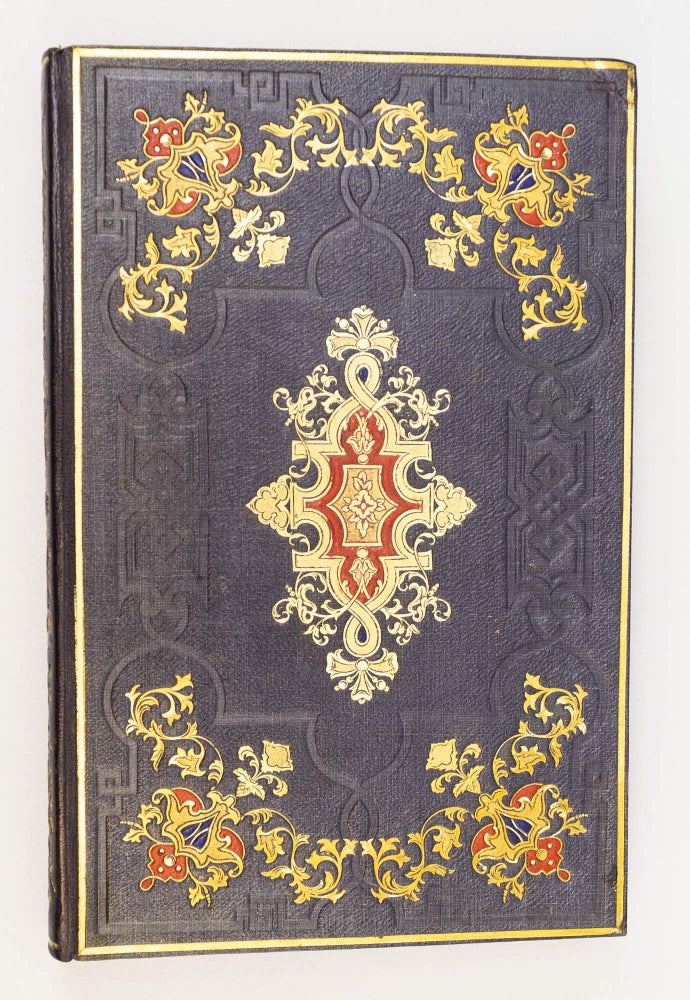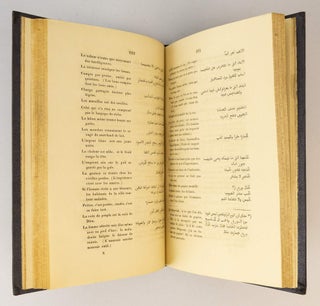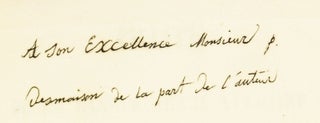TRAITÉ DE LA LANGUE ARABE VULGAIRE.
(Leipsic [Leipzig]: Guillaume Vogel fils, 1848). 225 x 142 mm. (8 3/4 x 5 1/2"). XXV pp., 4 p.l., 231 pp. FIRST EDITION.
VERY ATTRACTIVE AND UNUSUAL CONTEMPORARY BLUE CLOTH BY F. J. CRUSIUS OF LEIPZIG (his ticket on verso of front free endpaper), WITH ORNATE STAMPED DECORATION IN THE ROMANTIC STYLE in gilt, colors, and blind, covers with rocaille frame and large central arabesque in red and gilt, smooth black roan spine with stylized gilt vine, brown and tan lattice-work printed endpapers and edges. Text in French and Arabic on facing pages. Front flyleaf with AUTHOR'S INK PRESENTATION INSCRIPTION to Monsieur P. Desmaison (see below). ◆One corner slightly bumped, leaves lightly and uniformly browned (due to paper quality), a few other trivial imperfections, but A NEARLY FINE AND VERY PLEASING COPY, with few signs of wear inside or out.
This is a beautifully preserved copy of a rare guide to spoken Arabic that features special provenance, in an embossed and painted cloth binding that can almost pass as onlaid morocco. Our author, Sheikh Mouhammad Ayaad El-Tantavy [or al-Tantawi] (1810-61), was an instructor of languages and literature at Al Azahr University in Egypt when he came to the attention of Russian diplomats in Cairo, whose interpreter had attended his classes. The Russian consul to the Ottoman Empire, which then occupied Egypt, requested that El-Tantavy be lent to the Institute of Oriental Languages in the Russian foreign ministry, and once he arrived in St. Petersburg in 1840, he never left. In addition to teaching languages at the school for Russian diplomats, he was a professor of Arabic at St. Petersburg University, eventually becoming the Chair of Arabic Studies. The present work is a guide to spoken Arabic for diplomats, with the parallel texts in Arabic and French, then the international language for diplomacy. France, Russia, and the Ottoman Empire had been engaged in a series of conflicts for some years, so this tool would have had very practical application. It is recommended in the 1855 book, "The Languages of the Seat of War in the East" by Friedrich Max Muller. The present copy is inscribed by the author to Jean-Jacques-Pierre Desmaisons (1807-73), the Franco-Russian director of training in Oriental languages in the Asiatic department of the Russian foreign ministry, and El-Tantavy's supervisor there. The fact that Desmaisons would not have needed to make practical use of our volume goes some way to account for its fine condition. Binder F. J. Crusius developed machinery to facilitate the lavish decoration of bindings in innovative ways--like using paint to imitate leather, as in the present example--achieving aesthetically pleasing results with far less labor and expense than would have been necessitated by hand work. The "Report of the Assessment Commission at the General German Industrial Exhibition in Munich in 1854" notes that Crusius displayed plan drawings of his invention at the fair. Copies of the first edition of this work are rare, with OCLC finding just 12 in libraries worldwide, and none in North America. We could find no copies recorded at auction. (ST14540)
Price: $7,500.00



